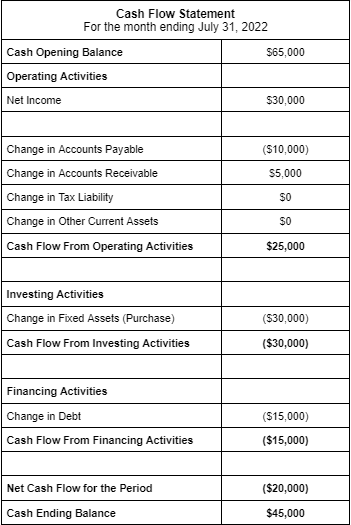What is a Cash Flow Statement & How to Understand It
- Gingerlin Mangulabnan

- Oct 19, 2022
- 3 min read
Updated: Oct 27, 2022
What is a Cash Flow Statement?
A cash flow statement is one of the three key financial statements that report the cash generated and spent during a specific period of time (e.g., a month, quarter, or year). This statement is connected with the income statement and balance sheet by showing how money moved in and out of the business. It measures how well a company manages its cash position - meaning how well the company generates cash to pay its debt obligations and fund its operating expenses.

Why is a Cash Flow Statement Important?
It shows your liquidity. So you will know what you can afford, and what you can’t.
It shows the changes in your assets, liabilities and equity. These are your cash inflows, outflows and cash being held that will measure your performance.
It predicts future cash flow. Meaning, you can plan for your business ahead of time.
If a company is funding losses from operations or financing investments by raising money (debt or equity) it will quickly become clear on the statement of cash flows.
How is Cash Flow Statement related with the Income Statement and the Balance Sheet?
In creating your Cash Flow Statement, you will need your Income Statement and Balance Sheet because you will get useful information from these two. The income statement lets you know how money entered and left your business, while the balance sheet shows how those transactions affect different accounts—like accounts receivable, inventory, and accounts payable.
Three Sections of the Statement of Cash Flow
Operating Activities - The principal revenue-generating activities of an organization and other activities that are not investing or financing; any cash flows from current assets and current liabilities.
Investing Activities - Any cash flows from the acquisition and disposal of long-term assets and other investments not included in cash equivalents
Financing Activities - Any cash flows that result in changes in the size and composition of the contributed equity capital or borrowings of the entity (i.e., bonds, stock, dividends)
How to Prepare a Statement of Cash Flow
The operating section of the statement of cash flows can be shown through either the direct method or the indirect method.
Direct Method - all the cash payments and receipts, including cash paid to suppliers, cash receipts from customers, and cash paid out in salaries.
Indirect Method - items such as net income, depreciation, etc. are used to arrive at cash flow. Therefore, you will identify any increases and decreases to asset and liability accounts that need to be added back to or removed from the net income figure, in order to identify an accurate cash inflow or outflow.
Example of Cash Flow Statement

How to read this Cash Flow Statement:
Cash Opening Balance: This is the amount of cash on hand at the beginning of the period for the report.
Operating Activities
Net Income: The Net Income is brought in from the Profit and Loss Statement, as it will include any money in and out during the course of the period.
Change in ….: These account for any discrepancy between the income and expenses reported on the Profit and Loss Statement, which get pulled into the Cash Flow Statement through the Net Income line, and cash that actually was spent through the period.
Change in Accounts Payable
Change in Accounts Receivable
Change in Tax Liability
Change in Current Assets
Investing Activities
Change in Fixed Assets: This accounts for the purchase or sell of any assets or other investing properties that is owned by the business, which do not reflect on the Net Income.
Financing Activities
Change in Debt: This accounts for any change in debt for the period, whether it is paying off a loan or receiving a loan.
Through this Cash Flow Statement you can see that while this business is showing a $30,000 net income for the period, which is a great sign, it actually had a negative cash flow of $20,000 for the period. Meaning the cash on hand is going down significantly.
Without this Cash Flow Statement and only relying on the Profit and Loss Statement, the business owner would assume they are profitable and continue as is, but actually the business could run out of cash quickly, without proper cash flow adjustments.
Summary
Cash flow statements are one of the most critical financial documents that a business prepares as it offers valuable insight into the health of the business. By learning how to read a cash flow statement and other financial documents, you can acquire the financial accounting skills needed to make smarter business and investment decisions, regardless of your position.
At Nuve, we help businesses to understand these financial documents and help your business grow. Click here to book a call with us and learn more!



Comments